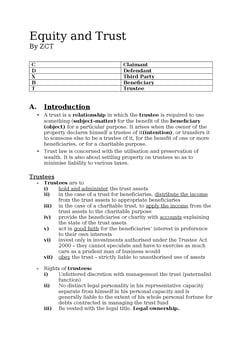Re Barlow’s Will Trusts [1979] 1 WLR 278, [1979] 1 All ER 296
Judgement for the case Re Barlow’s Will Trusts
Table Of Contents
KEY POINTS
-
Constructing a will requires clear intentions and adherence to legal guidelines.
It involves outlining the Testator's wishes for asset distribution while ensuring compliance with formal requirements, such as signing and witnessing.
Proper drafting is crucial to avoid ambiguity and ensure smooth execution of the will.
-
In a will, "family" typically refers to relatives by blood, marriage, or adoption, while "friends" include non-relatives.
It's essential to clearly define these terms in a will to prevent confusion or disputes over who is eligible to inherit.
Giving family and friends the option to buy the Testatrix's pictures can keep sentimental items within close circles. To avoid misunderstandings, this option should be clearly detailed, including who can purchase it, the price, and the timeframe for exercising it.
A class-based bequest, like "all my grandchildren," must be clear and identifiable. If the class is ambiguous or its members cannot be determined, the bequest might be invalidated. It's vital to define the class precisely to prevent legal disputes.
FACTS
-
Helen Alice Dorothy Barlow (“Testatrix”), who never married and possessed a substantial collection of pictures, detailed in her will that certain pictures were to be specifically bequeathed.
She directed that the remaining pictures should be held by Royal Exchange Assurance (“Executor”) in trust for sale.
The will stipulated that the Executor must permit any member of the Testatrix's family and friends who desired to purchase any of the pictures.
The valuation for the purchase was to be based on either the 1970 valuation or the probate value, whichever was lower, with the proceeds of the sale becoming part of the residuary estate.
-
The Executors initiated an originating summons seeking clarification on whether the direction allowing family and friends to purchase pictures was entirely void due to uncertainty.
The direction was void concerning friends but valid concerning family.
If the direction regarding family was deemed valid, the Executors sought clarity on who qualified as members of the Testatrix's family for the purpose of this directive.
JUDGEMENT
-
The court ruled as follows:
-
The provision in the Testatrix's will that allowed "friends" to purchase her pictures was deemed to be a series of individual options, not a class gift. While the term "friend" could be ambiguous, the court found that it was possible to identify people who fit the description.
It outlined the minimum requirements to qualify as a friend:
The relationship must have been long-standing.
The relationship should have been social, not business-related.
Even if there were long periods without contact, the individuals should have met frequently when circumstances allowed.
The term "family" was interpreted in its usual sense, referring to "blood relations." There was no need for an artificial interpretation to avoid uncertainty.
-
Thus, the court upheld the direction allowing family members to purchase the pictures according to this standard interpretation.
COMMENTARY
-
This case highlights the aspects of will construction and the importance of clarity in defining terms like "family" and "friends."
The Testatrix's decision to allow family and friends to purchase her pictures underscores the personal nature of asset distribution in a will.
However, the subsequent legal proceedings shed light on the challenges of interpreting such provisions.
-
The judgment emphasizes that while terms like "friend" may seem ambiguous, courts can establish clear criteria for their interpretation.
In this instance, the court outlined specific requirements for qualifying as a friend, providing a framework for determining eligibility.
The interpretation of the term "family" shows the significance of adhering to a common understanding unless there are compelling reasons for deviation.
By affirming the standard definition of "blood relations," the court provided clarity on who qualified as family members for the purpose of the directive.
This case reminds us of the complexities involved in will drafting and the need for precision to avoid ambiguity and legal disputes. It shows the importance of careful consideration and clear articulation of intentions to ensure the effective Execution of a Testator's wishes.
For Further Study on Re Barlow’s Will Trusts
Need instant answers? Our AI exam tutor is here to help.
Ask questions 🙋 Get answers 📔 It's simple 👁️👄👁️
Our AI is educated by the highest scoring students across all subjects and schools. Join hundreds of your peers today.
Get StartedSimilar Cases
Related Product Samples
These product samples contain the same concepts we cover in this case.

